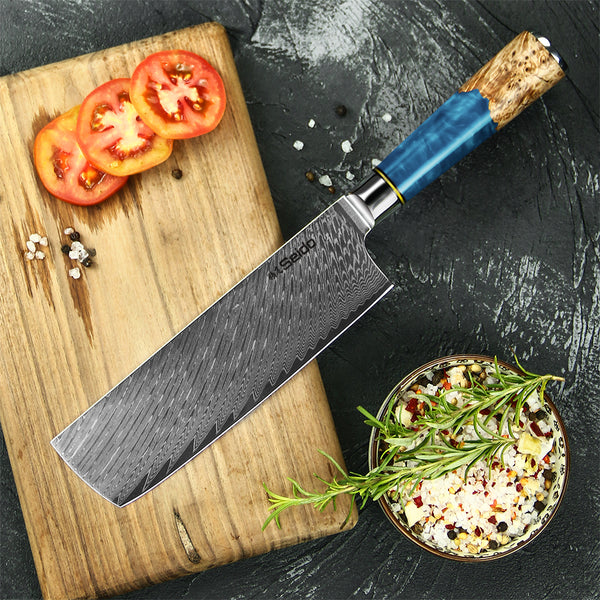Learning Japanese cutting techniques can greatly enhance your culinary skills as many of the techniques have been refined over centuries, such as the katsuramuki method of peeling vegetables. Here is an ultimate guide to the techniques used by many Japanese to cut vegetables.
WHAT MAKES JAPANESE CUTTING TECHNIQUES UNIQUE?
Japanese cutting methods emphasize precision and balance. Moreover, each cut combines skill and craftsmanship. To make efficient cuts, you'll need patience, discipline, and lots of practice. Of course, you'll also need an excellent Japanese Master Chef Knife.
ADVANTAGES OF A NAKIRI KNIFE
The nakiri knife has a flat blade and a squared-off tip, and it's ideal if you want to cut vegetables and herbs. Plus, the sharp edge ensures you'll get clean slices. Consider using the nakiri knife from our Executive Japanese Damascus Steel Knife Set.

Master Japanese Cutting Techniques With Santoku Knives!
TYPES OF JAPANESE VEGETABLE CUTS
The types of vegetable cuts the Japanese have used for centuries include the following.
1. TANZAKU-KIRI (短冊切) - Long Rectangular Strips
If you want long, rectangular slices, use the tanzaku-kiri vegetable cutting technique. You need precise knife skills to get the long slices to be uniform in appearance.
2. USUGIRI (薄切り) - "Thin" Cut
Usugiri is also known as the "thin" cut. This technique is used to cut vegetables into very thin slices so they can be added to sushi rolls and salads.
3. HANGETSU-GIRI (半月切り) - "Half Moon" Cut
Hangetsu-giri means "half-moon cut" in Japanese. This technique involves slicing your vegetables to create crescent shapes. It’s an ideal method if presentation is important for your dishes.
4. KAKUGIRI (角切り) - "Square" Cut
Kakugiri translates to "square cut" in Japanese. Cutting food with this technique will give you precise cubes. Besides being visually appealing, the cubes can also be used to add flavor to salads and soups.
5. SAINOME-KIRI (さいの目切り) - "Diced" Cut
Following the kakugiri technique, the sainome-kiri method for vegetable cutting emerges as a refined approach, involving the precise slicing of ingredients into smaller cubes.
6. KUSHIGATAGIRI (くし形切り) - "Comb Tooth" Cut
Kushigatagiri translates to "comb-tooth cut." This cutting style involves cutting food on a diagonal so that the edges are ridged. Make sure you use a sturdy cutting board, like our Gourmet Acacia, End Grain Cutting Board.

7. WAGIRI (輪切り) - "Round" Cut
This simple cutting technique creates round shapes. Wagiri is one of the most commonly used cutting methods in Japan. Vegetables cut into round slices can be used in stir-fries and salads.
8. BUTSUGIRI (ぶつ切り) - "Block" Cut
Butsugiri translates to "block cut" in Japanese. This method will give you rectangular blocks. Butsugiri is ideal for soups and sauces.
9. RANGIRI (乱切り) - "Random Shape" Cut
Rangiri means "random cut" in Japanese, and this technique involves cutting your vegetables into different shapes and sizes. While the style may seem haphazard, the goal is to provide a diverse texture.
10. HITOKUCHI-DAI NI KIRU (ひと口大に切る / 一口大に切る) - "Bite Sized" Cut
Hitokuchi-dai ni kiru, or "second cut of bite-sized pieces," involves chopping ingredients into even smaller pieces. The sizes are typically 3 centimeters in size.
11. NANAMEGIRI (斜め切り) - "Diagonal" Cut
Nanamegiri translates to "diagonal cut" and involves cutting food ingredients at an angle so that you get rhombus-shaped pieces.
12. KOGUCHIGIRI (小口切り) - "Small Round" Cut
Koguchigiri is also known as "small edge cuts," since you cut your ingredients into tiny, round pieces. This technique is ideal for garnishes.
13. ARARE-KIRI (あられ切り) - "Extra Small" Cut
Arare-kiri, or the "extra small cut," involves cutting food into bite-sized cubes. A further reduction from the aforementioned sainome-kiri and kaku-giri techniques results in even smaller cubes. Each size is roughly 5 millimeters.
14. ICHŌGIRI (いちょう切り) - "Ginkgo Leaf" Cut
Ichōgiri is when you slice your food into the shape of a ginkgo leaf. This decorative technique is ideal if you want to add a touch of elegance to your dishes.
15. ZAKU-KIRI (ザク切り) - "Rough" Cut
Zaku-kiri, or "rough cut" in Japanese, involves simply cutting your food into large pieces. This technique is great for leafy vegetables, such as cabbage or lettuce.
16. HYOUSHIGIKIRI (拍子木切り) - "Wooden Clapper" Cut
Hyoushigikiri translates to "wooden clapper cut" and is used when you want thin, rectangular Japanese veggies that resemble wooden poles or clappers.
17. SOGIGIRI (そぎ切り) - "Thin Sliced Angle" Cut
This "thin slice cut" involves cutting your food at an angle, creating diagonal or slanted cuts. Use your Japanese chef's knife to make thin slices parallel to your cutting board.
18. KAZARI-KIRI (飾り切り) - "Decorative" Cut
Kazari-kiri translates to "decorative cut," and it is a technique often reserved for special occasions and showcases. The technique involves sculpting food ingredients into works of art.
THE PERFECTION OF JAPANESE CUTTING TECHNIQUES
Food ingredients look better when you cut them differently, which is why the Japanese have perfected their cutting styles. Whether you are making sushi rolls or garnishing a dish with fan-shaped ichōgiri or a rangiri cut, these Japanese cutting styles will infuse your dishes with visual appeal and enhanced flavor.




